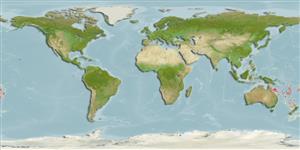Élasmobranches (requins et raies) (sharks and rays) >
Carcharhiniformes (Ground sharks) >
Scyliorhinidae (Cat sharks) > Scyliorhininae
Etymology: Cephaloscyllium: cephalus, from kephale (Gr.), head, referring to its very broad and depressed head; skylion, Greek for dogfish or small shark. (See ETYFish); signourum: signa, from signum (L.), flag; oura (Gr.), tail, but used here as an adjective (tailed), referring to distinctive flag-like dark marking on terminal lobe of caudal fin. (See ETYFish).
More on authors: Last, Séret & White.
Environment: milieu / climate zone / depth range / distribution range
Écologie
marin benthopélagique; profondeur 480 - 700 m (Ref. 76946). Tropical
Western Pacific: Australia; possibly occurring off the islands of New Caledonia, Fiji, and Vanuatu.
Taille / Poids / Âge
Maturity: Lm ? range ? - ? cm
Max length : 74.1 cm TL (female)
Description synthétique
Morphologie | Morphométrie
This medium-sized species has the following set of characters which was based on the holotype: head 7.5% TL in height, trunk 16.3% TL in width; origin of first dorsal-fin is over the anterior pelvic-fin base; prenarial 3.6% TL in length; preorbital snout length is 2.0 times prenarial length, 3.0 in prepectoral length, 6.6 in prepelvic length; snout-vent length long, 51.7% TL; nostril width 2.7% TL; eye-spiracle space narrow, 0.5% TL; pectoral fin medium-sized, its height 12.8% TL, posterior margin 11.9% TL; anal fin tall, 4.0% TL; anal-caudal space is 5.0% TL; precaudal length is 76% TL; interdorsal space is 6.6% TL; teeth with 3 well-developed cusps near symphysis of upper jaw; mostly unicuspidate flank denticles; back without the greatly enlarged denticles; adult clasper unknown; vertebral centra 115-116; tooth count high, 84 teeth in upper jaws, 97 in lower jaws; color of upper half of body medium brown, with a variegated pattern that is not clearly demarcated from the ventral surface; dark saddles (10) evident on body and tail; dorsal fins are pale variegated; dark blotch absent over gills; marking on posterior margin of terminal lobe of caudal fin dark, anteriorly directed, V-shaped; upper surface of pectoral-fin with a dark brown central blotch; centered over ventral origin of caudal fin is a well-developed saddle; ventral surface is uniformly greyish or white in color; juveniles are pale with dark transverse markings appearing as narrow bars and hollow saddles; markings between spiracles not separated into two unconnected pseudo-ocelli (Ref. 76946).
Life cycle and mating behavior
Maturité | Reproduction | Frai | Œufs | Fécondité | Larves
Last, P.R., B. Séret and W.T. White, 2008. New swellsharks (Cephaloscyllium: Scyliorhinidae) from the Indo-Australian region. In Last, P.R., White, W.T. & Pogonoski, J.J. (eds.): Descriptions of New Australian Chondrichthyans. CSIRO Marine and Atmospheric Research Paper no. 22. (Ref. 76946)
Statut dans la liste rouge de l'IUCN (Ref. 130435)
Menace pour l'homme
Harmless
Utilisations par l'homme
Plus d'informations
PaysZones FAOÉcosystèmesOccurrencesIntroductionsStocksÉcologieRégime alimentaireÉléments du régime alimentaireConsommation alimentaireRation
Noms communsSynonymesMétabolismePrédateursÉcotoxicologieReproductionMaturitéFraiRassemblement de ponteFéconditéŒufsDéveloppement de l'œuf
Taille/ÂgeCroissanceLongueur-poidsLongueur-longueurFréquences de longueursMorphométrieMorphologieLarvesDynamique des populations larvairesRecrutementAbondanceBRUVS
RéférencesAquacultureProfil d'aquacultureSouchesGénétiqueElectrophoresesHéritabilitéPathologiesTraitementNutrientsMass conversion
CollaborateursImagesStamps, Coins Misc.SonsCiguateraVitesseType de nageSurface branchialeOtolithesCerveauxVision
Outils
Articles particuliers
Télécharger en XML
Sources Internet
Estimates based on models
Preferred temperature (Ref.
123201): 6.2 - 10.2, mean 7.7 °C (based on 119 cells).
Phylogenetic diversity index (Ref.
82804): PD
50 = 0.5000 [Uniqueness, from 0.5 = low to 2.0 = high].
Bayesian length-weight: a=0.00263 (0.00139 - 0.00497), b=3.21 (3.04 - 3.38), in cm total length, based on LWR estimates for this (Sub)family-body shape (Ref.
93245).
Niveau trophique (Ref.
69278): 4.1 ±0.5 se; based on size and trophs of closest relatives
Résilience (Ref.
120179): Milieu, temps minimum de doublement de population : 1,4 à 4,4 années (Preliminary K or Fecundity.).
Fishing Vulnerability (Ref.
59153): Moderate to high vulnerability (50 of 100).
